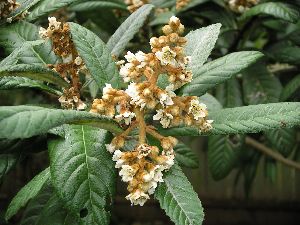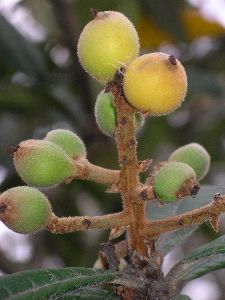Loquat
by Valerie (September 13, 2004)
|
The only tree in our yard to actually produce edible fruit, the loquat (Eriobotrya japonica) is ideally adapted to our area. In fact, it might be a bit too well adapted and naturalizes rather easily. In spite of the huge inedible leathery leaves, it seems that the local fauna can't complain about a plant that produces an ample supply of pollen and nectar and a tasty crop of fruit at a time when few other plants are doing the same.
Loquats originated in China, later being cultivated in Japan. They are now found in similar climates all over the world and there are many cultivars commercially available. Other common names for the loquat include nespole, nispero, Japanese medlar, Japanese plum, biwa and pipa. The loquat is an evergreen small tree or big shrub, depending on how it is pruned. It is very drought tolerant and the seeds germinate without fail. After obtaining one plant from a nursery, we've had no shortage of seedlings to try in different places in our yard.
The loquat starts to bloom in the late autumn. Temperatures are usually still very warm and the flowers attract all manner of insects, including migrating monarch butterflies, honeybees, small wasps and flies. The smell of the blossoms is pretty overpowering, and I find it rather sickly sweet, with an old-fashioned taint. It is not all that pleasant, but not nauseating either, just different than anything else.
The fruits form quickly after the blossoms are pollinated, but they take a long time to grow and ripen. This could be because of the cold weather, short days, or just the habit of the tree. When the loquats are ripe, they turn a pretty golden yellow bordering on orange. They taste like a combination of fruits, including grape, apricot, plum and pear. Although very tasty, the fruits are small and contain two or three huge seeds in the middle. The skin of the fruit is sort of tough and I sometimes peel it off, especially if it is damaged by insects. The seeds germinate very easily and the very young trees are easy to transplant. They grow slowly and the leaves are a nice addition to our understory gardens. The leaves never wilt and don't seem to be affected by drought, heat or cold. When the leaves do fall off, however, they are rather messy because of their large size, and they don't compost well because they are so thick and tough. The fruit of the loquat, besides being good to eat fresh, is often used in jams, jellies, and pies. A tea is made from the leaves, and this is commercially available. It is said to cure a variety of ills, including stomach upset, pain, and even cancer. The seeds are also eaten as a cure for cancer, but I can't find any reliable documentation that this actually works. |
 We do not have the ideal situation for our loquat to produce fruit on a regular basis. During the summer, the tree is in the shade of several larger trees. Because the surrounding trees are deciduous, though, during the winter the loquat does receive sun. Besides not enough sun, our winter temperatures often get too low and the buds, flowers, or ripening fruit may freeze and shrivel up. Even with two or sometimes three separate bloom periods (depending on when we get rain and what the temperatures are doing), none of the fruit ripens most years.
We do not have the ideal situation for our loquat to produce fruit on a regular basis. During the summer, the tree is in the shade of several larger trees. Because the surrounding trees are deciduous, though, during the winter the loquat does receive sun. Besides not enough sun, our winter temperatures often get too low and the buds, flowers, or ripening fruit may freeze and shrivel up. Even with two or sometimes three separate bloom periods (depending on when we get rain and what the temperatures are doing), none of the fruit ripens most years.
